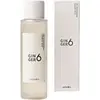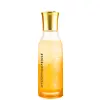What's inside
What's inside
 Key Ingredients
Key Ingredients

 Benefits
Benefits

 Concerns
Concerns

 Ingredients Side-by-side
Ingredients Side-by-side

Zingiber Officinale Water
MaskingButylene Glycol
HumectantDipropylene Glycol
Humectant1,2-Hexanediol
Skin ConditioningGlycereth-26
HumectantNiacinamide
SmoothingGlycerin
HumectantPanthenol
Skin ConditioningBetaine
HumectantGlycereth-25 PCA Isostearate
EmulsifyingNeofinetia Falcata Callus Culture Extract
Skin ConditioningPerilla Frutescens Extract
Skin ConditioningCarbomer
Emulsion StabilisingTromethamine
BufferingEthylhexylglycerin
Skin ConditioningPropanediol
SolventSodium Hyaluronate
HumectantZingiber Officinale Root Extract
MaskingAdenosine
Skin ConditioningGlyceryl Acrylate/Acrylic Acid Copolymer
HumectantDisodium EDTA
Pvm/Ma Copolymer
Emulsion StabilisingTocopherol
AntioxidantAllantoin
Skin ConditioningRosa Damascena Flower Oil
MaskingTrehalose
HumectantCentella Asiatica Extract
CleansingCamellia Japonica Flower Extract
EmollientPolygonum Cuspidatum Root Extract
AntioxidantScutellaria Baicalensis Root Extract
AstringentCamellia Sinensis Leaf Extract
AntimicrobialGlycyrrhiza Glabra Root Extract
BleachingChamomilla Recutita Flower Extract
MaskingRosmarinus Officinalis Leaf Extract
AntimicrobialAcetyl Hexapeptide-8
HumectantAcetyl Tetrapeptide-2
Skin ConditioningCopper Tripeptide-1
Skin ConditioningHexapeptide-9
Skin ConditioningNonapeptide-1
Skin ConditioningPalmitoyl Oligopeptide
CleansingPalmitoyl Pentapeptide-4
Skin ConditioningPalmitoyl Tetrapeptide-7
Skin ConditioningPalmitoyl Tripeptide-1
Skin ConditioningPalmitoyl Tripeptide-5
Skin ConditioningTripeptide-1
Skin ConditioningZingiber Officinale Water, Butylene Glycol, Dipropylene Glycol, 1,2-Hexanediol, Glycereth-26, Niacinamide, Glycerin, Panthenol, Betaine, Glycereth-25 PCA Isostearate, Neofinetia Falcata Callus Culture Extract, Perilla Frutescens Extract, Carbomer, Tromethamine, Ethylhexylglycerin, Propanediol, Sodium Hyaluronate, Zingiber Officinale Root Extract, Adenosine, Glyceryl Acrylate/Acrylic Acid Copolymer, Disodium EDTA, Pvm/Ma Copolymer, Tocopherol, Allantoin, Rosa Damascena Flower Oil, Trehalose, Centella Asiatica Extract, Camellia Japonica Flower Extract, Polygonum Cuspidatum Root Extract, Scutellaria Baicalensis Root Extract, Camellia Sinensis Leaf Extract, Glycyrrhiza Glabra Root Extract, Chamomilla Recutita Flower Extract, Rosmarinus Officinalis Leaf Extract, Acetyl Hexapeptide-8, Acetyl Tetrapeptide-2, Copper Tripeptide-1, Hexapeptide-9, Nonapeptide-1, Palmitoyl Oligopeptide, Palmitoyl Pentapeptide-4, Palmitoyl Tetrapeptide-7, Palmitoyl Tripeptide-1, Palmitoyl Tripeptide-5, Tripeptide-1
Water
Skin ConditioningGlycerin
HumectantLactic Acid
BufferingTromethamine
BufferingPropylene Glycol
HumectantNiacinamide
SmoothingButylene Glycol
HumectantFructooligosaccharides
HumectantBeta Vulgaris Root Extract
Skin ConditioningAllantoin
Skin ConditioningAloe Barbadensis Leaf Extract
EmollientMaltodextrin
AbsorbentCalcium Pantothenate
Urea
BufferingCaprylyl Glycol
EmollientMagnesium Lactate
BufferingPotassium Lactate
BufferingPapain
Skin ConditioningEthylhexylglycerin
Skin ConditioningPanthenol
Skin ConditioningBiotin
AntiseborrhoeicFolic Acid
Skin ConditioningAscorbic Acid
AntioxidantTocopherol
AntioxidantRetinyl Palmitate
Skin ConditioningPyridoxine Hcl
Skin ConditioningArachis Hypogaea Oil
Skin ConditioningCalendula Officinalis Flower Extract
MaskingProline
Skin ConditioningAlanine
MaskingSerine
MaskingPhenoxyethanol
PreservativePEG-40 Hydrogenated Castor Oil
EmulsifyingDisodium EDTA
Calendula Officinalis Flower
Skin ConditioningXanthan Gum
EmulsifyingSodium Citrate
BufferingHydroxypropyl Cyclodextrin
MaskingCitric Acid
BufferingCyanocobalamin
Skin Conditioning7-Dehydrocholesterol
Emulsion StabilisingLecithin
EmollientAcetyl Glutamine
Skin ConditioningSh-Oligopeptide-1
Skin ConditioningSh-Oligopeptide-2
Skin ConditioningSh-Polypeptide-1
Skin ConditioningSh-Polypeptide-9
Skin ConditioningSh-Polypeptide-11
Bacillus
Skin ConditioningSodium Hyaluronate
Humectant1,2-Hexanediol
Skin ConditioningParfum
MaskingWater, Glycerin, Lactic Acid, Tromethamine, Propylene Glycol, Niacinamide, Butylene Glycol, Fructooligosaccharides, Beta Vulgaris Root Extract, Allantoin, Aloe Barbadensis Leaf Extract, Maltodextrin, Calcium Pantothenate, Urea, Caprylyl Glycol, Magnesium Lactate, Potassium Lactate, Papain, Ethylhexylglycerin, Panthenol, Biotin, Folic Acid, Ascorbic Acid, Tocopherol, Retinyl Palmitate, Pyridoxine Hcl, Arachis Hypogaea Oil, Calendula Officinalis Flower Extract, Proline, Alanine, Serine, Phenoxyethanol, PEG-40 Hydrogenated Castor Oil, Disodium EDTA, Calendula Officinalis Flower, Xanthan Gum, Sodium Citrate, Hydroxypropyl Cyclodextrin, Citric Acid, Cyanocobalamin, 7-Dehydrocholesterol, Lecithin, Acetyl Glutamine, Sh-Oligopeptide-1, Sh-Oligopeptide-2, Sh-Polypeptide-1, Sh-Polypeptide-9, Sh-Polypeptide-11, Bacillus, Sodium Hyaluronate, 1,2-Hexanediol, Parfum
 Reviews
Reviews

Ingredients Explained
These ingredients are found in both products.
Ingredients higher up in an ingredient list are typically present in a larger amount.
1,2-Hexanediol is a synthetic liquid and another multi-functional powerhouse.
It is a:
- Humectant, drawing moisture into the skin
- Emollient, helping to soften skin
- Solvent, dispersing and stabilizing formulas
- Preservative booster, enhancing the antimicrobial activity of other preservatives
Allantoin is a soothing ingredient known for its protective and moisturizingg properties. Because of this, it is often added to products with strong active ingredients.
Studies show higher concentrations of this ingredient can promote wound healing.
Though it can be derived from the comfrey plant, allantoin is produced synthetically for cosmetic products to ensure purity.
Learn more about AllantoinButylene Glycol (or BG) is used within cosmetic products for a few different reasons:
Overall, Butylene Glycol is a safe and well-rounded ingredient that works well with other ingredients.
Though this ingredient works well with most skin types, some people with sensitive skin may experience a reaction such as allergic rashes, closed comedones, or itchiness.
Learn more about Butylene GlycolDisodium EDTA plays a role in making products more stable by aiding other preservatives.
It is a chelating agent, meaning it neutralizes metal ions that may be found in a product.
Disodium EDTA is a salt of edetic acid and is found to be safe in cosmetic ingredients.
Learn more about Disodium EDTAEthylhexylglycerin (we can't pronounce this either) is commonly used as a preservative and skin softener. It is derived from glyceryl.
You might see Ethylhexylglycerin often paired with other preservatives such as phenoxyethanol. Ethylhexylglycerin has been found to increase the effectiveness of these other preservatives.
Glycerin is already naturally found in your skin. It helps moisturize and protect your skin.
A study from 2016 found glycerin to be more effective as a humectant than AHAs and hyaluronic acid.
As a humectant, it helps the skin stay hydrated by pulling moisture to your skin. The low molecular weight of glycerin allows it to pull moisture into the deeper layers of your skin.
Hydrated skin improves your skin barrier; Your skin barrier helps protect against irritants and bacteria.
Glycerin has also been found to have antimicrobial and antiviral properties. Due to these properties, glycerin is often used in wound and burn treatments.
In cosmetics, glycerin is usually derived from plants such as soybean or palm. However, it can also be sourced from animals, such as tallow or animal fat.
This ingredient is organic, colorless, odorless, and non-toxic.
Glycerin is the name for this ingredient in American English. British English uses Glycerol/Glycerine.
Learn more about GlycerinNiacinamide is a multitasking form of vitamin B3 that strengthens the skin barrier, reduces pores and dark spots, regulates oil, and improves signs of aging.
And the best part? It's gentle and well-tolerated by most skin types, including sensitive and reactive skin.
You might have heard of "niacin flush", or the reddening of skin that causes itchiness. Niacinamide has not been found to cause this.
In very rare cases, some individuals may not be able to tolerate niacinamide at all or experience an allergic reaction to it.
If you are experiencing flaking, irritation, and dryness with this ingredient, be sure to double check all your products as this ingredient can be found in all categories of skincare.
When incorporating niacinamide into your routine, look out for concentration amounts. Typically, 5% niacinamide provides benefits such as fading dark spots. However, if you have sensitive skin, it is better to begin with a smaller concentration.
When you apply niacinamide to your skin, your body converts it into nicotinamide adenine dinucleotide (NAD). NAD is an essential coenzyme that is already found in your cells as "fuel" and powers countless biological processes.
In your skin, NAD helps repair cell damage, produce new healthy cells, support collagen production, strengthen the skin barrier, and fight environmental stressors (like UV and pollution).
Our natural NAD levels start to decline with age, leading to slower skin repair, visible aging, and a weaker skin barrier. By providing your skin niacinamide, you're recharging your skin's NAD levels. This leads to stronger, healthier, and younger looking skin.
Another name for vitamin B3 is nicotinamide. This vitamin is water-soluble and our bodies don't store it. We obtain Vitamin B3 from either food or skincare. Meat, fish, wheat, yeast, and leafy greens contain vitamin B3.
The type of niacinamide used in skincare is synthetically created.
Learn more about NiacinamidePanthenol is a common ingredient that helps hydrate and soothe the skin. It is found naturally in our skin and hair.
There are two forms of panthenol: D and L.
D-panthenol is also known as dexpanthenol. Most cosmetics use dexpanthenol or a mixture of D and L-panthenol.
Panthenol is famous due to its ability to go deeper into the skin's layers. Using this ingredient has numerous pros (and no cons):
Like hyaluronic acid, panthenol is a humectant. Humectants are able to bind and hold large amounts of water to keep skin hydrated.
This ingredient works well for wound healing. It works by increasing tissue in the wound and helps close open wounds.
Once oxidized, panthenol converts to pantothenic acid. Panthothenic acid is found in all living cells.
This ingredient is also referred to as pro-vitamin B5.
Learn more about PanthenolSodium Hyaluronate is hyaluronic acid's salt form. It is commonly derived from the sodium salt of hyaluronic acid.
Like hyaluronic acid, it is great at holding water and acts as a humectant. This makes it a great skin hydrating ingredient.
Sodium Hyaluronate is naturally occurring in our bodies and is mostly found in eye fluid and joints.
These are some other common types of Hyaluronic Acid:
Learn more about Sodium HyaluronateTocopherol (also known as Vitamin E) is a common antioxidant used to help protect the skin from free-radicals and strengthen the skin barrier. It's also fat soluble - this means our skin is great at absorbing it.
Vitamin E also helps keep your natural skin lipids healthy. Your lipid skin barrier naturally consists of lipids, ceramides, and fatty acids. Vitamin E offers extra protection for your skin’s lipid barrier, keeping your skin healthy and nourished.
Another benefit is a bit of UV protection. Vitamin E helps reduce the damage caused by UVB rays. (It should not replace your sunscreen). Combining it with Vitamin C can decrease sunburned cells and hyperpigmentation after UV exposure.
You might have noticed Vitamin E + C often paired together. This is because it is great at stabilizing Vitamin C. Using the two together helps increase the effectiveness of both ingredients.
There are often claims that Vitamin E can reduce/prevent scarring, but these claims haven't been confirmed by scientific research.
Learn more about TocopherolTromethamine helps balance the pH and improve the texture of a product. It is synthetically created.
As an emulsifier, Tromethamine prevents oil and water ingredients from separating. This helps stabilize the product and elongate a product's shelf life. Tromethamine also makes a product thicker.
Tromethamine helps balance the pH level of a product. Normal pH level of skin is slightly acidic (~4.75-5.5). The acidity of our skin is maintained by our glands and skin biome. Being slightly acidic allows our skin to create an "acid mantle". This acid mantle is a thin barrier that protects our skin from bacteria and contaminants.
Oral Tromethanmine is an anti-inflammatory drug but plays the role of masking, adding fragrance, and/or balancing pH in skincare.
1,3-Propanediol, 2-amino-2-(hydroxymethyl)-
Learn more about Tromethamine